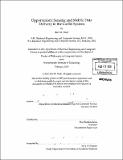Opportunistic sensing and mobile data delivery in the CarTel System
Author(s)
Hull, Bret Warren, 1980-
DownloadFull printable version (18.94Mb)
Other Contributors
Massachusetts Institute of Technology. Dept. of Electrical Engineering and Computer Science.
Advisor
Hari Balakrishnan.
Terms of use
Metadata
Show full item recordAbstract
Wide-area sensor systems enable a broad class of applications, including the fine-grained monitoring of traffic congestion, road surface conditions, and pollution. This dissertation shows that it is possible to build a low-cost, wide-area sensor system. Our approach relies on two techniques: using existing motion from such sources of mobility as cars and people to provide coverage (opportunistic mobility), and using the abundance of short duration network connections to provide low-cost data delivery (opportunistic networking). We use these two techniques to build a mobile sensor computing system called CarTel, to collect, process, deliver, and visualize spatially diverse data. CarTel consists of three key components: hardware placed in users' cars to provide remote sensing, a communication stack called CafNet to take advantage of opportunistic networking, and a web-based portal for data visualization. This dissertation describes the design and implementation of these three components. In addition, we analyze the properties of opportunistic networking and mobility. To show the viability of opportunistic networking, we studied Internet access from moving vehicles and found that the median duration of link layer connectivity at vehicular speeds was 13 seconds, that the median connection upload bandwidth was 30 KBytes/s, and that the mean duration between successful associations to APs was 75 seconds. To show the viability of opportunistic mobility, we used a simulation and found that after as little as 100 drive hours, a CarTel deployment could achieve over 80 percent coverage of useful roads for a traffic congestion monitoring application.
Description
Thesis (Ph. D.)--Massachusetts Institute of Technology, Dept. of Electrical Engineering and Computer Science, 2010. Cataloged from PDF version of thesis. Includes bibliographical references (p. 94-102).
Date issued
2010Department
Massachusetts Institute of Technology. Department of Electrical Engineering and Computer SciencePublisher
Massachusetts Institute of Technology
Keywords
Electrical Engineering and Computer Science.